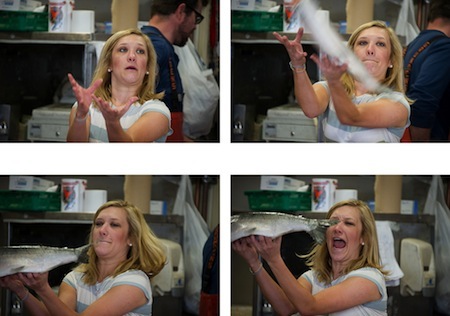 Evolution
Evolution
 Intelligent Design
Intelligent Design
Flying Fish in the Darwin Magic Show

First there was one; now, like magic, there are two independent flying fish families that “evolved.” They just evolved.
Saying something doesn’t make it so. Darwinists have a bad habit of saying this or that wonder “evolved” with no sense of obligation to say how it evolved. Tracking down the individual lucky accidents that led to a complex adaptation (behavior included) is too hard, so here’s what they do: assume evolution, then just assert that the trait evolved, because evolution is already assumed to be a fact.
Worse, they say that it “evolved so that” the animal could do something, like fly. This is a technical foul in evolutionary theory. Evolution cannot plan to arrange mutations toward a goal. If it were a law of nature that one animal “evolved to” fly, then science would predict every animal would fly, including pigs. In the following case, we see how evolutionists commit these fouls. Most fish evolve to swim, we have been taught, but two families independently “evolved so that” they could fly as well.
The BBC News reports the discovery of an “exceptionally preserved” fossil of a flying fish in Middle Triassic strata from China, dated 235-242 million years ago. Nothing in the data or pictures would lead an impartial observer to conclude unguided Darwinian evolution produced this fish. The artist reconstruction shows a beautifully adapted fish with fins outstretched to glide over the water, as modern flying fish do.
The observations, please:
The study shows that the new flying fish, named Potanichthys xingyiensis, was 153mm long and had the “unusual combination of morphological features” associated with gliding strategy in fishes.
This is the earliest known fossil of a flying fish, and it is already well adapted for flying. Moreover, it was found on the opposite side of the world (China) from previously known fossils of its family, found in Austria and Italy.
Weaved around these sentences are statements about geographical distribution, species count and other empirical matters. The magic act begins when we are told that these fish are among the survivors of a mass extinction that destroyed most of earth’s species:
The Triassic period saw the re-establishment of ecosystems after the Permian mass extinction.
The fossils represent new evidence that marine ecosystems re-established more quickly than previously thought.
In evolutionary parlance, “re-established” does not mean simply that the numbers of survivors increased. It means that Evolution told life to be fruitful and multiply, to once again fill the earth and the seas. The agent of this creation is natural selection, producing endless forms most beautiful after destroying 90% of them.
At the end of this Darwinian trick, the magician announces the evolutionary climax:
Gliding has evolved many times in animals, such as in frogs, lizards and mammals but has “evolved only twice among fishes”, according to the study: once in the Triassic Thoracopteridae fishes and again in the modern-day Exocoetidae family.
Scientists suggest both families of flying fishes evolved so that they could escape marine predators by “gliding” over-water to safety. (Emphasis added.)
You may applaud now, please.
It may well be that flying fish gained their adaptations from fish that did not have them. It would seem improbable, but not impossible, to imagine the fins growing longer as certain fish leaped above the water to avoid predators. Perhaps this kind of adaptability is itself a product of design. But with no fossil record of the transition, we need a lot more than a Darwinian evolutionist’s word for it that a blind, purposeless process produced a functional adaptation.
Instead, we are told that these fish “evolved so that they could escape predators by ‘gliding’ over-water to safety.” No transitional forms are needed; no accounting of mutations is required. The magic occurs in a black box the audience can’t see, and presto! — a fully functioning flying fish leaps above the water, complete with brain software to know how to use its new equipment.
If we demanded that evolutionists drop all teleological language to be consistent with their anti-teleological worldview, evolution would be a very boring act. If we insisted on looking into the black box to see how the trick was done, there would be a loud hissing sound as the hot air escapes. What would be left, if anything, would undoubtedly be a finely tuned, designed mechanism for producing adaptive change. That’s not natural selection; that’s intelligent design.
Image: Catching Salmon at Pike Place Fish Market — Seattle, howardignatius/Flickr.
